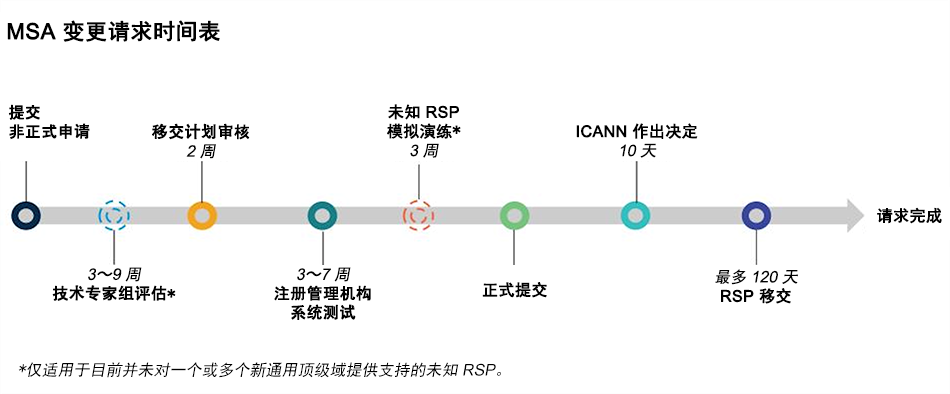实质性转包安排 (MSA) 变更
注:所有语种版本中,英文版为官方版本,其他语种版本仅供参考.
概述
本网页为注册管理运营机构提供向 ICANN 组织申请批准实质性转包安排 (MSA) 变更的相关指导。
与《注册管理机构协议》规范 10 第 6 节中定义的任何关键职能相关的所有转包安排均被视为"实质性转包安排 (MSA)"。运营一项或多项关键职能的转包商称为"后端注册管理运行机构"或"注册管理机构服务提供商 (RSP)"。
受 MSA 变更流程影响的关键职能包括:
- DNS 解析
- DNSSEC 正确签名的区域(如果注册管理机构提供了 DNSSEC)
- 共享注册系统 (SRS),通常借由可扩展供应协议 (EPP) 的方式提供
- 注册数据目录服务 (RDDS),例如,通过端口 43 和基于网络的服务提供的注册数据访问协议 (RDAP) 和 WHOIS。
ICANN 组织通过 MSA 变更流程对 RSP 进行测试和评估,以确保其有能力以稳定和安全的方式运营顶级域 (TLD)。ICANN 组织还要求注册管理运行机构提交一份移交计划,说明如何以稳定和安全的方式,协调和完成相关服务从一个 RSP 移交至另一个 RSP。
以下是 MSA 流程的一般时间表。单击此处可了解更详细的工作流程。
提交前:考虑事项和准备工作
以下步骤重点介绍了注册管理机构在域名服务门户 (NSp) 中提交 MSA 变更请求之前应考虑的事项和应做的准备工作。
第 1 步:考虑相关事务。变更 RSP 可能会导致其他相应变更。例如,考虑:
- 由于 RSP 变更,您是否会对《注册管理机构协议》(RA) 附录 A 中的注册管理机构服务进行任何修改?
- 除了 MSA 变更之外,您是否还会将 TLD 分配给另一个不同实体?
对注册管理机构服务的修改:如果您提议的 RSP 所提供的注册管理机构服务与您当前的 RSP 不同(例如,注册管理机构锁定、IDN 语言/文字),那么您需要在提交 MSA 变更请求之前,先提交注册管理机构服务评估政策 (RSEP) 请求来更新附录 A 中的相关内容。我们鼓励您通过电话会议来商讨适当的步骤。
分配 TLD:除了 MSA 变更之外,如果您还计划将 TLD RA 分配给另一个不同实体,则需要先完成其中一项事务,然后再着手启动另一项事务。我们强烈建议您通过电话会议来商讨可用选项,这样还可帮助您更好地了解相关事务的影响。有关分配 TLD 的更多信息,请参阅分配页面。
第 2 步:了解时间表。给自己留出至少 7-12 周的时间来完成向 ICANN 组织提出 MSA 变更请求这项工作。在您的时间表中,应根据您的业务需求和要求来考虑 ICANN 组织在处理 MSA 变更方面的要求,包括测试。例如,考虑:
- 您与当前 RSP 的协议是否即将终止?
- 从您当前的 RSP 移交至新的 RSP 需要多长时间?
第 3 步:与客户经理组织一次电话磋商,以确保您了解相关流程。您的客户经理可以向您简要介绍流程所涉及的内容,通知您需要准备的文档和测试工作,并帮助确保您了解提出 MSA 变更请求所需的事项。做好提交请求的准备工作会让流程更加高效。
第 4 步:审核并准备所需的文件。提前做好计划,审核提供的材料,准备要提交的文件,并注意以下事项:
- 查看注册管理机构系统测试页面和资源。
- 确定您提议的 RSP 是新的(未知)RSP 还是现有(已知)RSP。未知 RSP 是指当前未对一个或多个新通用顶级域 (gTLD) 提供支持的提供商。
- 对于未知 RSP,您必须提交对MSA 技术问题的答复。如果您希望移交至未知 RSP,则需要完成一些额外的审核、测试和步骤。有关这些额外要求的更多详细信息,请参阅 MSA 变更指南。
- 制定移交计划(请参阅移交计划指南)。
- 了解与您请求的 MSA 变更类型(变更为未知 RSP 或变更为已知 RSP)相关的费用。
- 查看 MSA 变更工作流程。
资源
- MSA 变更指南 - 说明如何在域名服务门户中提交 MSA 变更请求的服务请求。
- 移交计划指南 - 为提交 MSA 变更请求制定移交计划时可用的资源。
- 注册管理机构系统测试 - 有关 MSA 变更过程中注册管理机构系统测试 (RST) 部分的信息。
- MSA 技术问题 - 如果提议的 RSP 当前未运营一个或多个新通用顶级域注册管理机构(未知或"新"RSP),需要在请求中提供此文件。
- MSA 变更工作流程 - MSA 变更流程的直观概述。
要求一览表(按 MSA 变更类型)
| 要求 | 已知 RSP | 未知* RSP |
|---|---|---|
非正式提交 |
✔ |
✔ |
|
技术评估 (预计评估费用 14,300 美元) |
✔ |
|
移交计划审批 |
✔ |
✔ |
注册管理机构系统测试 |
✔ |
✔ |
模拟演练 |
✔ |
|
正式提交/ICANN 审核 |
✔ |
✔ |
ICANN 作出决定 |
✔ |
✔ |
RSP 移交 |
✔ |
✔ |
*目前未对新通用顶级域提供支持

